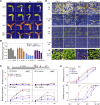Light and Abscisic Acid Coordinately Regulate Greening of Seedlings
- PMID: 32414897
- PMCID: PMC7333693
- DOI: 10.1104/pp.20.00503
Light and Abscisic Acid Coordinately Regulate Greening of Seedlings
Abstract
The greening of etiolated seedlings is crucial for the growth and survival of plants. After reaching the soil surface and sunlight, etiolated seedlings integrate numerous environmental signals and internal cues to control the initiation and rate of greening thus to improve their survival and adaption. However, the underlying regulatory mechanisms by which light and phytohormones, such as abscisic acid (ABA), coordinately regulate greening of the etiolated seedlings is still unknown. In this study, we showed that Arabidopsis (Arabidopsis thaliana) DE-ETIOLATED1 (DET1), a key negative regulator of photomorphogenesis, positively regulated light-induced greening by repressing ABA responses. Upon irradiating etiolated seedlings with light, DET1 physically interacts with FAR-RED ELONGATED HYPOCOTYL3 (FHY3) and subsequently associates to the promoter region of the FHY3 direct downstream target ABA INSENSITIVE5 (ABI5). Further, DET1 recruits HISTONE DEACETYLASE6 to the locus of the ABI5 promoter and reduces the enrichments of H3K27ac and H3K4me3 modification, thus subsequently repressing ABI5 expression and promoting the greening of etiolated seedlings. This study reveals the physiological and molecular function of DET1 and FHY3 in the greening of seedlings and provides insights into the regulatory mechanism by which plants integrate light and ABA signals to fine-tune early seedling establishment.
© 2020 American Society of Plant Biologists. All Rights Reserved.
Figures






Similar articles
-
FAR-RED ELONGATED HYPOCOTYL3 and FAR-RED IMPAIRED RESPONSE1 transcription factors integrate light and abscisic acid signaling in Arabidopsis.Plant Physiol. 2013 Oct;163(2):857-66. doi: 10.1104/pp.113.224386. Epub 2013 Aug 14. Plant Physiol. 2013. PMID: 23946351 Free PMC article.
-
Arabidopsis DE-ETIOLATED1 represses photomorphogenesis by positively regulating phytochrome-interacting factors in the dark.Plant Cell. 2014 Sep;26(9):3630-45. doi: 10.1105/tpc.114.130666. Epub 2014 Sep 23. Plant Cell. 2014. PMID: 25248553 Free PMC article.
-
The miR396-GRFs Module Mediates the Prevention of Photo-oxidative Damage by Brassinosteroids during Seedling De-Etiolation in Arabidopsis.Plant Cell. 2020 Aug;32(8):2525-2542. doi: 10.1105/tpc.20.00057. Epub 2020 Jun 2. Plant Cell. 2020. PMID: 32487564 Free PMC article.
-
Abscisic acid, high-light, and oxidative stress down-regulate a photosynthetic gene via a promoter motif not involved in phytochrome-mediated transcriptional regulation.Mol Plant. 2008 Jan;1(1):75-83. doi: 10.1093/mp/ssm007. Epub 2007 Oct 8. Mol Plant. 2008. PMID: 20031916
-
Emerging Roles of FHY3 and FAR1 as System Integrators in Plant Development.Plant Cell Physiol. 2023 Oct 16;64(10):1139-1145. doi: 10.1093/pcp/pcad068. Plant Cell Physiol. 2023. PMID: 37384577 Review.
Cited by
-
DET1 modulates ATAF1-repressed thermosensory elongation through ubiquitination in Arabidopsis.Plant Cell Rep. 2024 Dec 17;44(1):7. doi: 10.1007/s00299-024-03402-9. Plant Cell Rep. 2024. PMID: 39688715
-
Cotyledon opening during seedling deetiolation is determined by ABA-mediated splicing regulation.EMBO Rep. 2025 Jul;26(14):3663-3678. doi: 10.1038/s44319-025-00495-5. Epub 2025 Jun 18. EMBO Rep. 2025. PMID: 40533537 Free PMC article.
-
Genome-Wide Identification and Functional Characterization of FAR1-RELATED SEQUENCE (FRS) Family Members in Potato (Solanum tuberosum).Plants (Basel). 2023 Jul 7;12(13):2575. doi: 10.3390/plants12132575. Plants (Basel). 2023. PMID: 37447143 Free PMC article.
-
Basic Protein Modules Combining Abscisic Acid and Light Signaling in Arabidopsis.Front Plant Sci. 2022 Jan 3;12:808960. doi: 10.3389/fpls.2021.808960. eCollection 2021. Front Plant Sci. 2022. PMID: 35046987 Free PMC article. Review.
-
HY5 and ABI5 transcription factors physically interact to fine tune light and ABA signaling in Arabidopsis.Plant Mol Biol. 2021 Sep;107(1-2):117-127. doi: 10.1007/s11103-021-01187-z. Epub 2021 Sep 7. Plant Mol Biol. 2021. PMID: 34490593
References
-
- Chen K, Li GJ, Bressan RA, Song CP, Zhu JK, Zhao Y(2020) Abscisic acid dynamics, signaling, and functions in plants. J Integr Plant Biol 62: 25–54 - PubMed
Publication types
MeSH terms
Substances
LinkOut - more resources
Full Text Sources
Molecular Biology Databases

